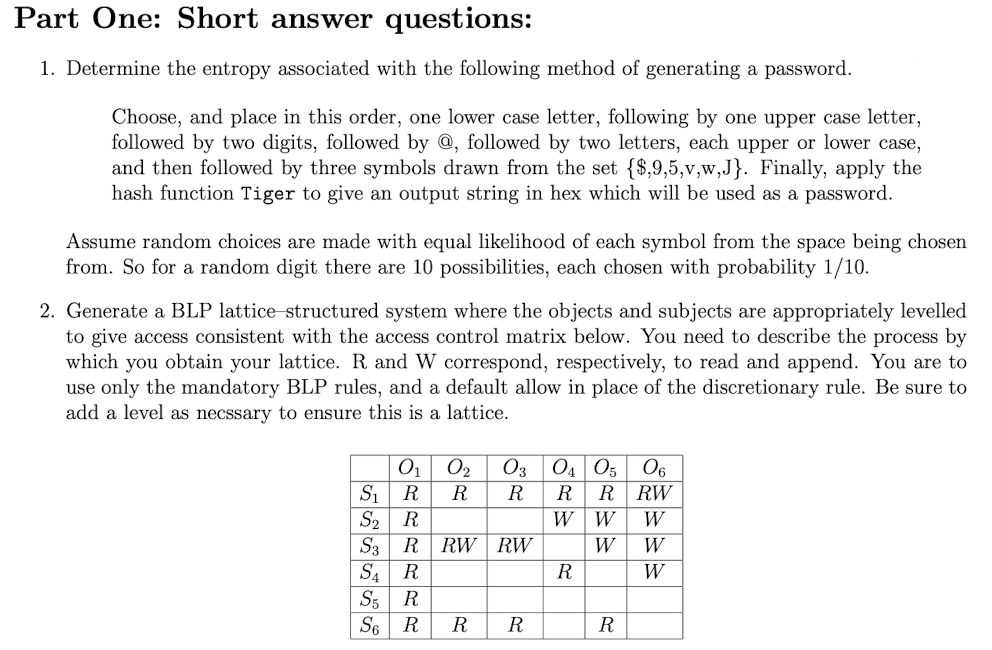1. Determine the entropy associated with the following method of generating a password. Choose, and place in this order, one lower case letter, following by one upper case letter, followed by two digits, followed by @, followed by two letters, each upper or lower case, and then followed by three symbols drawn from the set {$,9,5,v,w,J}. Finally, apply the hash function Tiger to give an output string in hex which will be used as a password. Assume random choices are made with equal likelihood of each symbol from the space being chosen from. So for a random digit there are 10 possibilities, each chosen with probability 1/10.
1. Determine the entropy associated with the following method of generating a password. Choose, and place in this order, one lower case letter, following by one upper case letter, followed by two digits, followed by @, followed by two letters, each upper or lower case, and then followed by three symbols drawn from the set {$,9,5,v,w,J}. Finally, apply the hash function Tiger to give an output string in hex which will be used as a password. Assume random choices are made with equal likelihood of each symbol from the space being chosen from. So for a random digit there are 10 possibilities, each chosen with probability 1/10.
Database System Concepts
7th Edition
ISBN:9780078022159
Author:Abraham Silberschatz Professor, Henry F. Korth, S. Sudarshan
Publisher:Abraham Silberschatz Professor, Henry F. Korth, S. Sudarshan
Chapter1: Introduction
Section: Chapter Questions
Problem 1PE
Related questions
Question
module is csci262 system security.
Need help on this. TIA!

Transcribed Image Text:Part One: Short answer questions:
1. Determine the entropy associated with the following method of generating a password.
Choose, and place in this order, one lower case letter, following by one upper case letter,
followed by two digits, followed by @, followed by two letters, each upper or lower case,
and then followed by three symbols drawn from the set {$,9,5,v,w,J}. Finally, apply the
hash function Tiger to give an output string in hex which will be used as a password.
Assume random choices are made with equal likelihood of each symbol from the space being chosen
from. So for a random digit there are 10 possibilities, each chosen with probability 1/10.
2. Generate a BLP lattice structured system where the objects and subjects are appropriately levelled
to give access consistent with the access control matrix below. You need to describe the process by
which you obtain your lattice. R and W correspond, respectively, to read and append. You are to
use only the mandatory BLP rules, and a default allow in place of the discretionary rule. Be sure to
add a level as necssary to ensure this is a lattice.
0₁
R
0₂
R
S5 R
S6 R
S₁
S₂ R
S3 R RW RW
S4 R
03 04 05 06
R
R R RW
W W
W
W
W
W
R
R
R
R
Expert Solution
This question has been solved!
Explore an expertly crafted, step-by-step solution for a thorough understanding of key concepts.
Step by step
Solved in 2 steps

Knowledge Booster
Learn more about
Need a deep-dive on the concept behind this application? Look no further. Learn more about this topic, computer-science and related others by exploring similar questions and additional content below.Recommended textbooks for you

Database System Concepts
Computer Science
ISBN:
9780078022159
Author:
Abraham Silberschatz Professor, Henry F. Korth, S. Sudarshan
Publisher:
McGraw-Hill Education

Starting Out with Python (4th Edition)
Computer Science
ISBN:
9780134444321
Author:
Tony Gaddis
Publisher:
PEARSON

Digital Fundamentals (11th Edition)
Computer Science
ISBN:
9780132737968
Author:
Thomas L. Floyd
Publisher:
PEARSON

Database System Concepts
Computer Science
ISBN:
9780078022159
Author:
Abraham Silberschatz Professor, Henry F. Korth, S. Sudarshan
Publisher:
McGraw-Hill Education

Starting Out with Python (4th Edition)
Computer Science
ISBN:
9780134444321
Author:
Tony Gaddis
Publisher:
PEARSON

Digital Fundamentals (11th Edition)
Computer Science
ISBN:
9780132737968
Author:
Thomas L. Floyd
Publisher:
PEARSON

C How to Program (8th Edition)
Computer Science
ISBN:
9780133976892
Author:
Paul J. Deitel, Harvey Deitel
Publisher:
PEARSON

Database Systems: Design, Implementation, & Manag…
Computer Science
ISBN:
9781337627900
Author:
Carlos Coronel, Steven Morris
Publisher:
Cengage Learning

Programmable Logic Controllers
Computer Science
ISBN:
9780073373843
Author:
Frank D. Petruzella
Publisher:
McGraw-Hill Education